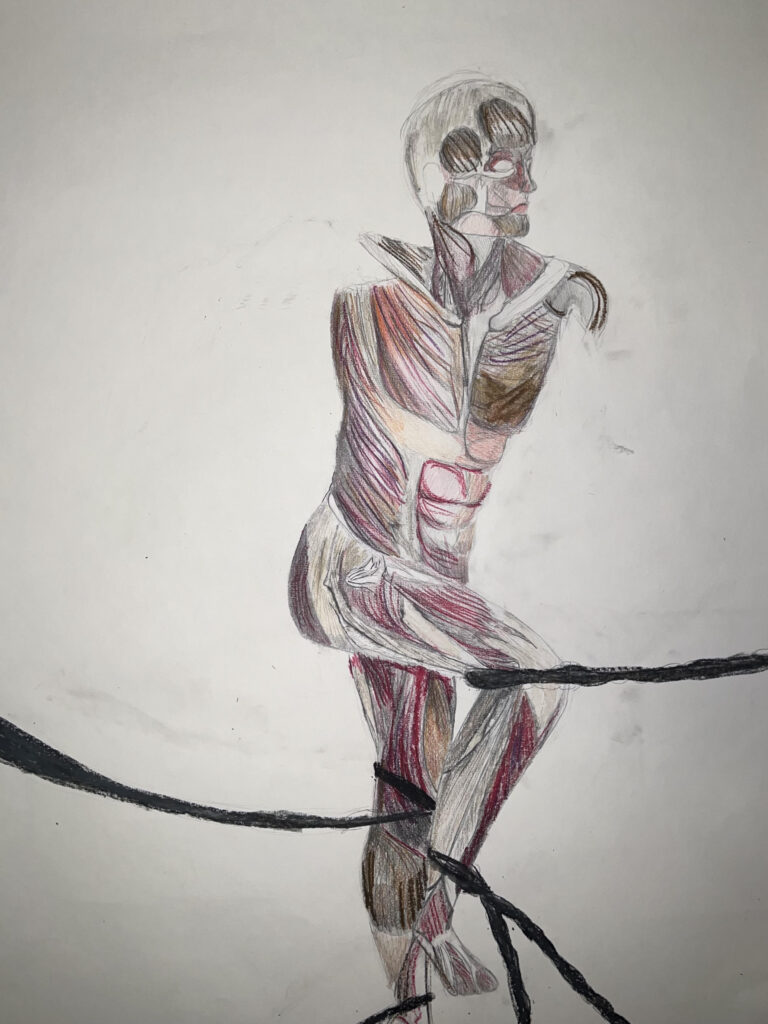I have created two abstract sketches depicting the skeletal muscle system positions during aerobic and anaerobic activities. Image one focuses in on the torso and leg skeletal muscles regions. Image two focuses on upper torse and the arm skeletal muscle regions. The art works relate to the class objective- “decribe how a muscle contraction is induced.” My short essay will focuses mainly on skeletal muscles and specific proteins that contribute to aerobic and anaerobic activities.
Firstly, contraction is triggered by the nervous system signals which generates action potentials. An action potential is the voltage rise and fall across the cellular membrane. Once the signal reaches the muscle fibers, a chemical reaction within the muscles starts to occur (Krans). Main proteins that aid muscle movement are filaments of thin actins and thick myosin. They work in a step-by-step process to convert chemical energy into mechanical energy (Coper, 2000). Myosin proteins group together to make molecular motors, or motor neurons. The motor neurons releases acetylcholine (ACh) which then bind to receptors. ACh binding then triggers AP in sarcolemma. (Swenney, Hammers, 2018) Once sarcolemma is triggered calcium ion (Ca2+) is released. Calcium ions bind to tropomyosin and connects myosin heads to actins. As the proteins slide past each other they create a connection between each other. The cross-bridge connection is formed from the myosin extend to the actin heads simultaneously as adenosine triphosphate (ATP) hydrolysis. (Brenner, 1987). Voluntary muscles contraction is then occurred by the cross-bridge cycling of myosin and actins.
Two daily activities which involve muscle contraction are moderate aerobic and anaerobic exercises. Both exercises involve the presence of ATP which is obtained from breaking down glucose, fatty acids, and blood-borne glucose. ATP can be obtained in several methods throughout performing physical activities (Vorkick, 2021). In image one, I depict my interpretation of the aerobic activity. The artwork describes how leg muscles are extended and pulled back towards the center of the body. Aerobic exercises use continuous movement induced by the active presence of oxygen-rich blood. Oxygen helps provide support to ATP breaking down several nutrients in order to produce mechanical energy during a prolonged period of physical activity (Cleveland Medical, 2019). In image two I depict an image of anaerobic activity. Anaerobic activities are induced by short outbursts of energy provided in aiding muscle movement. Anaerobic tasks are independent of oxygen usage only being support by stored or generated adenosine triphosphate (ATP). For the first few seconds of anaerobic exercise, ATP is generated by breaking down by what is stored in the muscles. Then as time furthers, ATP starts to be generated by breaking creatine phosphate and direct phosphorylation. Then roughly around the end of the exercise, ATP is produced by oxidizing broken down glycogen molecules. (Chaudhry, Varacallo, 2021).
It is important to understand how specific muscle contractions are induced. Proper education of ATP breakdown and elements involved in muscle contraction allows us to understand what nutrients to consume daily. Without formal knowledge, our bodies are put at more of a risk of skeletal muscle failure. The skeletal muscle system relies on proper dieting, reasonable weight training, and staying hydrated.
Work Cited
Sahlin, Kent. “Muscle Energetics during Explosive Activities and Potential Effects of Nutrition and Training.” Sports Medicine (Auckland, N.Z.), Springer International Publishing, 30 Oct. 2014, https://www.ncbi.nlm.nih.gov/pmc/articles/PMC4213384/.
Chaudrhy, R., & Varacello, M. “Biochemistry, glycolysis – statpearls – NCBI bookshelf”. National Library of Medicine. 2021, August 17. https://www.ncbi.nlm.nih.gov/books/NBK482303/
Linda J.Vorvick. “Anaerobic” Medline Plus. National Library of Medicine. Reviewed 5 May 2021. https://medlineplus.gov/ency/article/002230.htm
Michele Fecteau, DO and Tom Ravin, MD. “Prolotherapy or the Injection Treatment of Ligamentous Laxity.” University of Pittersburg Medical Care. Healthwise Publishing. 2022.
Cooper GM. “Actin, Myosin, and Cell Movement” The Cell: A Molecular Approach. 2nd edition. National Library of Medicine. Sinauer Associated. 2000. https://www.ncbi.nlm.nih.gov/books/NBK9961/
Alice Callahan “Nutrition: Science and Everyday Appilicastion. Fuel Storage for Exericise.” Open Oregon. Powerbooks publishing. https://openoregon.pressbooks.pub/nutritionscience/chapter/10b-fuel-sources-exercise/
Mary. K. Mulcahey, MD. “Aerobic Exercise.” OrthoInfo. Published by American Academy of Orthopedic Surgeons. December 2019. https://orthoinfo.aaos.org/en/staying-healthy/aerobic-exercise/
Jacob L. Krans. “Muscle Contractions: How Neurotransmitters And Chemical Reactions Move Muscles And Bones.” Visible Body. 2022. https://www.visiblebody.com/learn/muscular/muscle-contractions#:~:text=1.,cell%20called%20a%20motor%20neuron.
H. Lee Sweeney, David W. Hammers “Muscle Contraction.” Cold Spring Harbor Perspectives in Biology. Published by Old Spring Harbor Laboratory Press. 1 July. 2018. https://cshperspectives.cshlp.org/content/10/2/a023200.short



Muscle Contraction is the movement of muscles whether that would be tightening, stretching, or shortening the muscles. With an objective of ‘describe how a Muscle Contraction is induced’, the essay talks about how Muscle Contractions are often triggered by signals from the nervous system which are the brain and the spinal cord, which would generate action potentials. Action potentials are the electrical rise and fall across the cellular membrane. In the essay, it covers how Muscle Contraction relates to Anaerobic and Aerobic exercise, to see how Muscle Contraction is induced by doing these activities. Both these activities require energy in the form of ATP which can be obtained by breaking down glucose, fatty acids, and blood-borne glucose. Anaerobic exercises are movements that are quick but take a lot of energy. It’s important for the body to make ATP at a fast pace, but the con is that only a small amount of ATP is made. Aerobic exercises are more relaxed and take up less energy than Anaerobic. As both the activities are started, ATP would right away be produced by the body by breaking down direct phosphorylation and creatine phosphate. The ATP produced would then be used for the mechanical work and that’s when muscle contraction occurs with calcium pumped in and out of muscles to allow movement. The first image shows the torso and leg skeletal muscles, and where and how they are stretched when doing activities. The second image shows the upper torso and arm skeletal muscles, and where and how they are stretched.